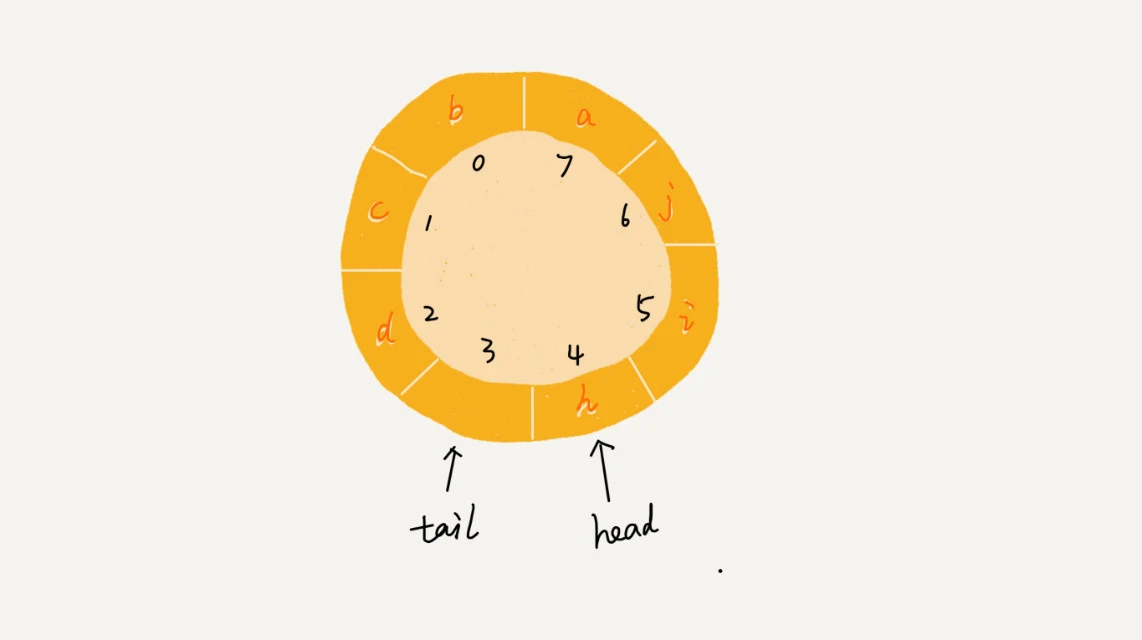队列¶
定义¶
队列(queue)是一种先进先出的、操作受限的线性表。
我们知道,栈只支持两个基本操作:入栈 push()和出栈 pop()。队列跟栈非常相似,支持的操作也很有限,最基本的操作也是两个:入队 enqueue(),放一个数据到队列尾部;出队 dequeue(),从队列头部取一个元素。
实现¶
队列的实现有很多种,比如用数组实现,用链表实现,用循环数组实现等等。用数组实现的队列叫作顺序队列,用链表实现的队列叫作链式队列。
顺序队列¶
这里我们用数组实现一个队列。
public class ArrayQueue {
private String[] items; // 数组
private int n = 0; // 数组大小
private int head = 0; // 队头下标
private int tail = 0; // 队尾下标
// 申请一个大小为capacity的数组
public ArrayQueue(int capacity) {
items = new String[capacity];
n = capacity;
}
// 入队操作,将item放入队尾
public boolean enqueue(String item) {
// 如果tail == n 表示队列已经满了
if (tail == n) return false;
items[tail] = item;
++tail;
return true;
}
// 出队操作,将队头元素返回
public String dequeue() {
// 如果head == tail 表示队列为空
if (head == tail) return null;
String ret = items[head];
++head;
return ret;
}
}
随着不停地进行入队、出队操作,head 和 tail 都会持续往后移动。当 tail 移动到最右边,即使数组中还有空闲空间,也无法继续往队列中添加数据了,这个问题该如何解决呢?
如果没有空闲空间了,我们只需要在入队时,再集中触发一次数据的搬移操作
// 入队操作,将item放入队尾
public boolean enqueue(String item) {
// tail == n表示队列末尾没有空间了
if (tail == n) {
// tail ==n && head==0,表示整个队列都占满了
if (head == 0) return false;
// 数据搬移
for (int i = head; i < tail; ++i) {
items[i-head] = items[i];
}
// 搬移完之后重新更新head和tail
tail -= head;
head = 0;
}
items[tail] = item;
++tail;
return true;
}
链式队列¶
链式队列的实现跟链表很像,只不过它是单向链表,而且只能从队尾插入元素,从队头删除元素。
public class LinkedQueue {
// 队列的队头和队尾
private Node head = null;
private Node tail = null;
// 入队
public void enqueue(String value) {
if (tail == null) {
Node newNode = new Node(value, null);
head = newNode;
tail = newNode;
} else {
tail.next = new Node(value, null);
tail = tail.next;
}
}
// 出队
public String dequeue() {
if (head == null) return null;
String value = head.data;
head = head.next;
if (head == null) {
tail = null;
}
return value;
}
}
public class Node {
public String data;
public Node next;
public Node(String data, Node next) {
this.data = data;
this.next = next;
}
}
循环队列¶
我们刚才用数组来实现队列的时候,在 tail==n 时,会有数据搬移操作,这样入队操作性能就会受到影响。那有没有办法能够避免数据搬移呢?我们来看看循环队列的解决思路。
循环队列是一种特殊的队列,它支持动态扩容。当队列满了之后,我们可以选择将数据搬移到数组的头部,这样就可以继续往队列中添加数据了。
public class CircularQueue {
// 数组:items,数组大小:n
private String[] items;
private int n = 0;
// head表示队头下标,tail表示队尾下标
private int head = 0;
private int tail = 0;
// 申请一个大小为capacity的数组
public CircularQueue(int capacity) {
items = new String[capacity];
n = capacity;
}
// 入队
public boolean enqueue(String item) {
// 队列满了当队满时,(tail+1)%n=head
if ((tail + 1) % n == head) return false;
items[tail] = item;
tail = (tail + 1) % n;
return true;
}
// 出队
public String dequeue() {
// 如果head == tail 表示队列为空
if (head == tail) return null;
String ret = items[head];
head = (head + 1) % n;
return ret;
}
}
应用¶
队列这种数据结构很基础,平时的业务开发不大可能从零实现一个队列,甚至都不会直接用到。而一些具有特殊特性的队列应用却比较广泛,比如阻塞队列和并发队列。
阻塞队列¶
阻塞队列其实就是在队列基础上增加了阻塞操作。简单来说,就是在队列为空的时候,从队头取数据会被阻塞。因为此时还没有数据可取,直到队列中有了数据才能返回;如果队列已经满了,那么插入数据的操作就会被阻塞,直到队列中有空闲位置后再插入数据,然后再返回。
我们可以使用阻塞队列,轻松实现一个“生产者 - 消费者模型”!这种基于阻塞队列实现的“生产者 - 消费者模型”,可以有效地协调生产和消费的速度。当“生产者”生产数据的速度过快,“消费者”来不及消费时,存储数据的队列很快就会满了。这个时候,生产者就阻塞等待,直到“消费者”消费了数据,“生产者”才会被唤醒继续“生产”。
并发队列¶
线程安全的队列我们叫作并发队列。最简单直接的实现方式是直接在 enqueue()、dequeue() 方法上加锁,但是锁粒度大并发度会比较低,同一时刻仅允许一个存或者取操作。实际上,基于数组的循环队列,利用 CAS 原子操作,可以实现非常高效的并发队列。这也是循环队列比链式队列应用更加广泛的原因。
对于大部分资源有限的场景,当没有空闲资源时,基本上都可以通过“队列”这种数据结构来实现请求排队。比如,操作系统中的进程调度、数据库连接池、线程池、消息队列等等,都是典型的“队列”应用场景。
